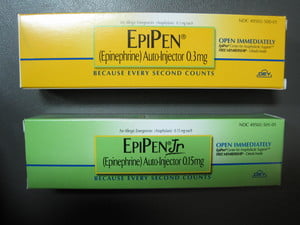At the age of 3, my child was diagnosed with a severe peanut allergy. His reaction is anaphylactic, which means his lungs are affected by histamine production when he inhales or consumes peanuts. Local reactions include hives up to 5 inches in diameter if he touches peanuts or peanut products. An EpiPen was prescribed to save his life, but it wasn’t until four years later that I learned five things I never knew about EpiPens.
You should carry two EpiPens at all times, not one
If you or your child has an anaphylactic reaction to an allergen, it is best to keep two Ep-Pens on your person at all times. A second shot of epinephrine can be administered five minutes after the first, though most allergists suggest waiting up to 15 minutes if the reaction is not life-threatening. If you have the slightest inclination that symptoms are getting worse after five minutes, use the second EpiPen.
EpiPens should be kept in all vehicles, even during the summer and winter months
Our allergist told us to keep two EpiPens at home, at school and in the car. Extreme heat and cold affect the strength of an EpiPen, according to CNNHealth, but a weak shot of epinephrine is better than no shot of epinephrine. Be prepared to replace the EpiPens stored in the car more often in the summer and winter.
The coolest place in a car is under the seat. Hanging shades on the windows can reduce internal temperatures during summer months. In the winter, wrap the EpiPens in a several layers of thermal fabric, like a small blanket or towel. Store in the glove compartment, where temperatures are slightly higher. This may prevent the EpiPen from freezing.
Schools don’t typically carry EpiPens on school-sponsored field trips
Did you ever ask your child’s teacher or school nurse about EpiPens and school field trips? I recently found out our son’s epinephrine shots were left at school every time he went on a school field trip. EpiPens need to be kept close to children with anaphylactic allergies at all times.
Your child’s teacher knows nothing about Epi-Pens or anaphylaxis
Very few teachers know the facts about EpiPen administration and symptoms of anaphylaxis. Our son’s teacher assured us she had other students with food allergies in her class during previous years, but when asked about the signs and symptoms of anaphylaxis, she couldn’t name one. She also had no idea how to use an EpiPen.
Children weighing more than 30 kilograms should use an EpiPen, not an EpiPen Jr.
When the allergist prescribed an adult-strength EpiPen I was appalled. How could a child just 6 years old use the same medication strength as an adult? The official EpiPen website suggests children and adults weighing more than 30 kilograms (66 pounds) use 0.30 mg of epinephrine, the strength of an EpiPen.
For children and adults with severe allergies and anaphylactic reactions to those allergies, EpiPens save lives. It is important to learn everything there is to know about epinephrine shots.
More from Summer on Allergies and Epi-Pens
An Invisible Threat: A Food Allergy Could Have Killed Our Son
Epi-Pens in School: Is Your Child Safe?

